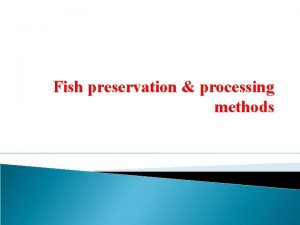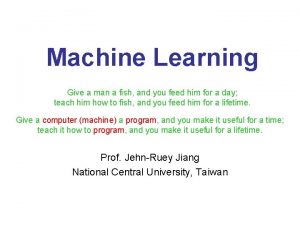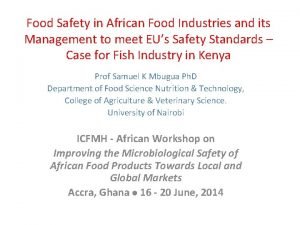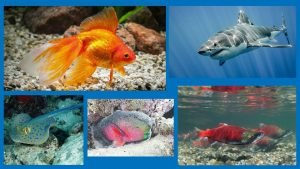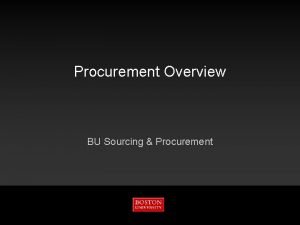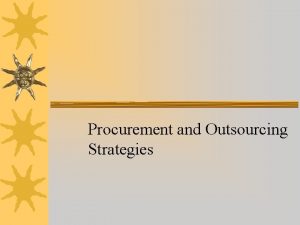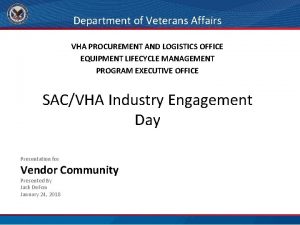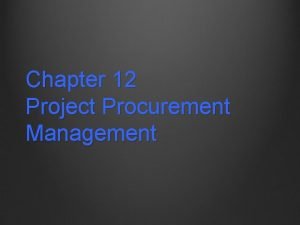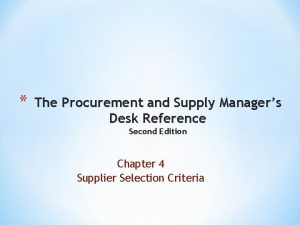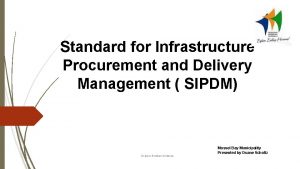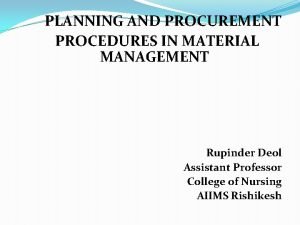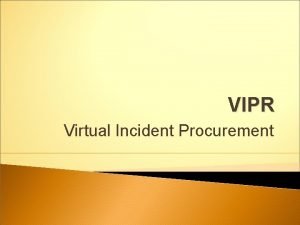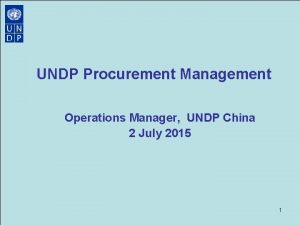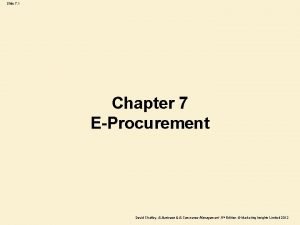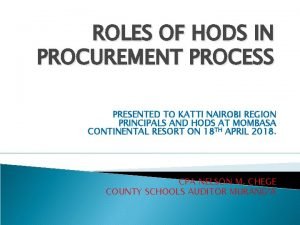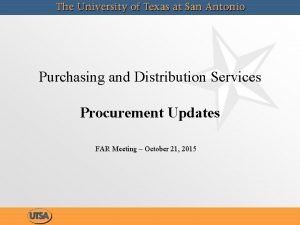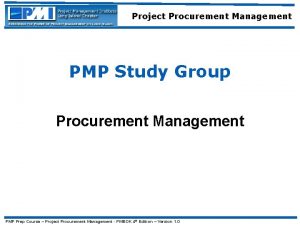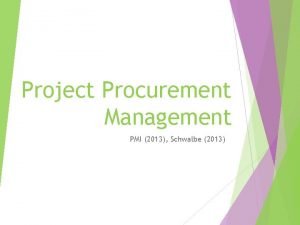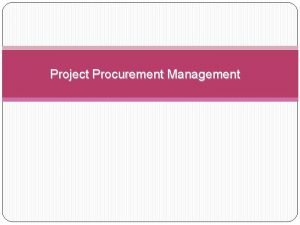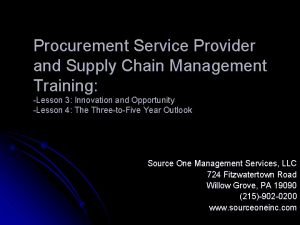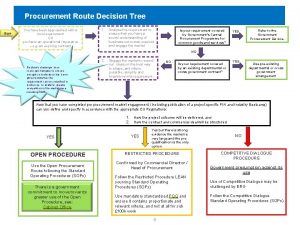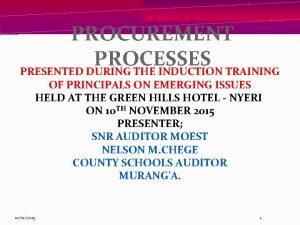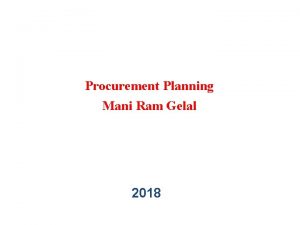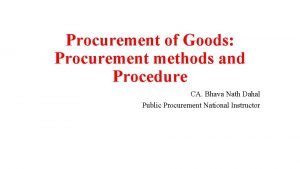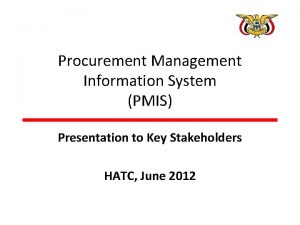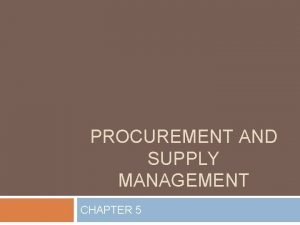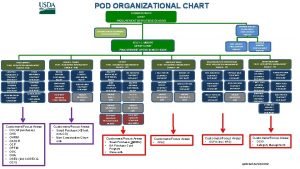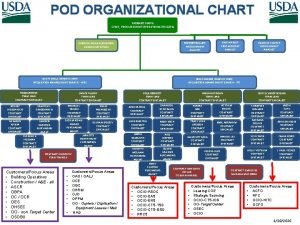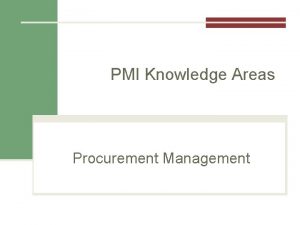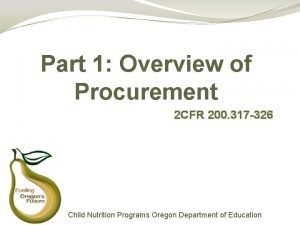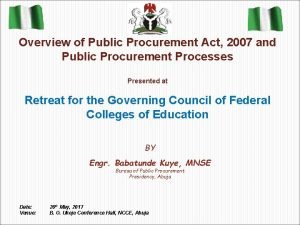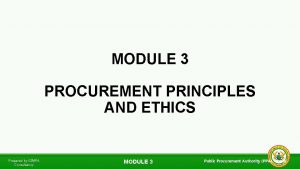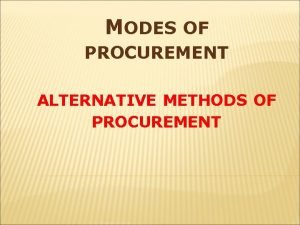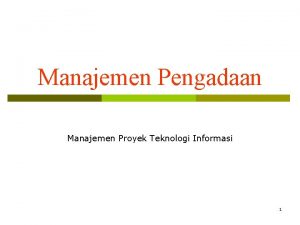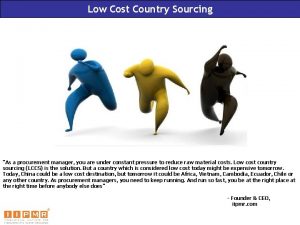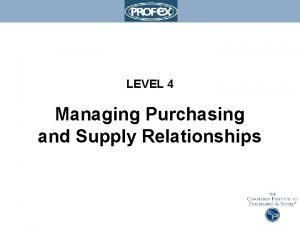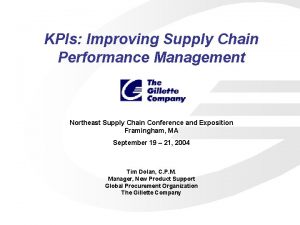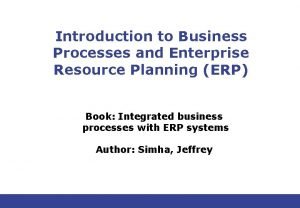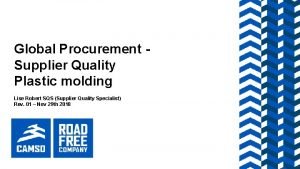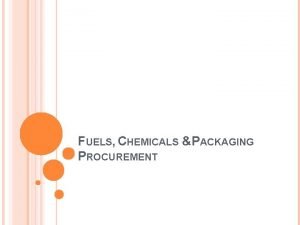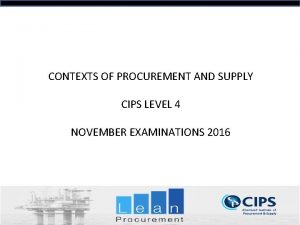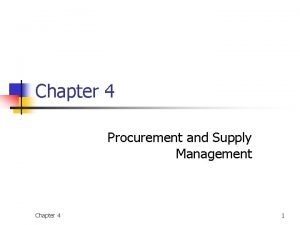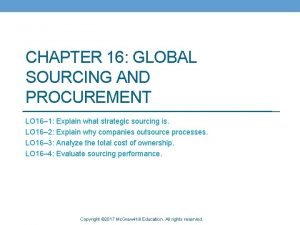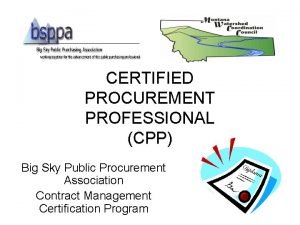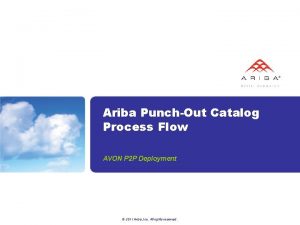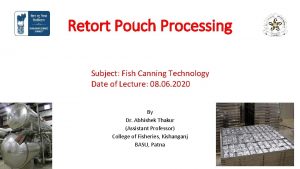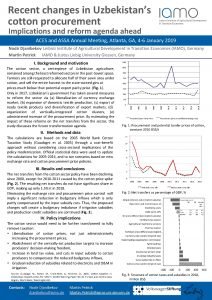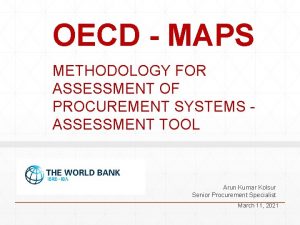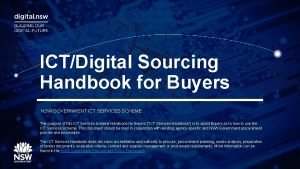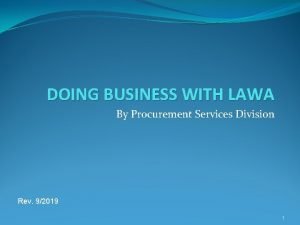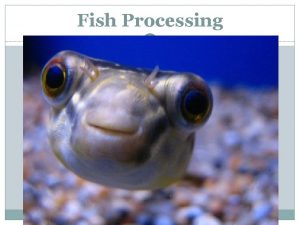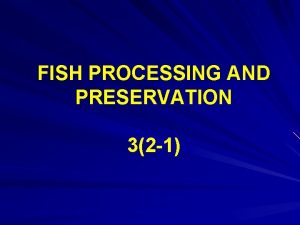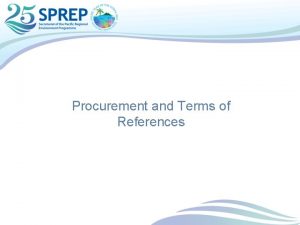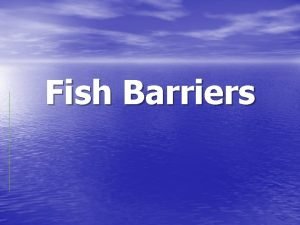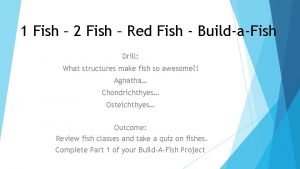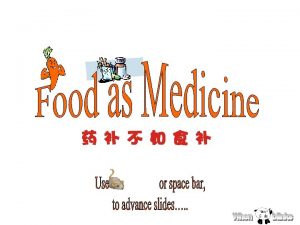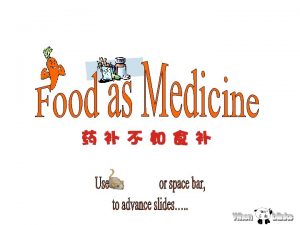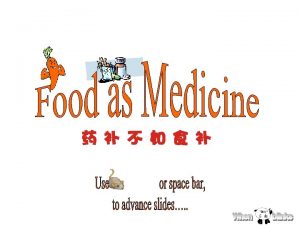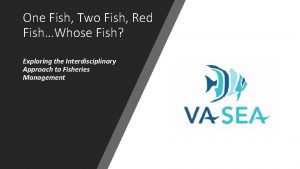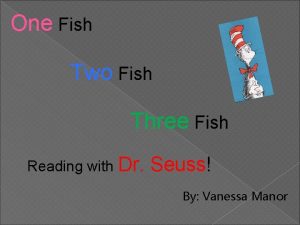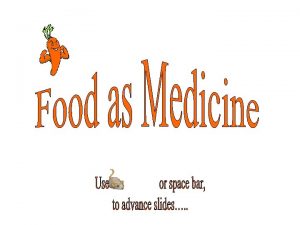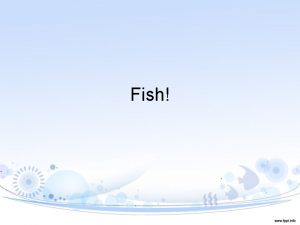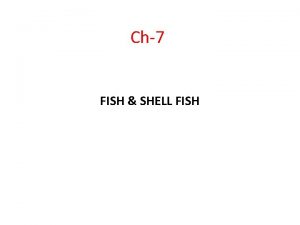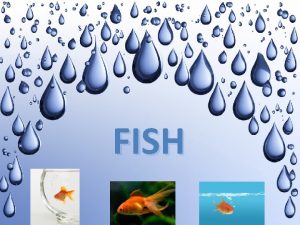Fish and Fish processing Fish Procurement What are










































































































- Slides: 106

Fish and Fish processing

Fish Procurement • • What are Seafoods? All water environments Sea animals – sea horses Sea plants – seaweeds and sea cucumbers etc

Procurement continued…… • • Distance from the facilities Poorly iced …………Fresh fish? ? Shell fishes – farmed – Aquaculture Locating fishes – Sonar / Helicopters/Large Trawler operations • Factory Ships - with fleets of smaller vessels – filleting machines, quick freezing facilities – fish meal processing – fish by products

Factory Ships

Factory Ship Contd……

Factory Ship contd………. .

Composition and Nutritive Value • Carbohydrate: Glycogen Eg. Oysters(2 3%) • Protein: Quality and Quantity – 20 % BV = 80. Rich in Lysine and Methionine ( Supplementary value) • Fat: 1 - 2. 8% Exceptions ranging from 4 – 10%. Omega 3 and Omega 6 fatty acids

WHY ARE FISH SO PERISHABLE? • Three Basic Reasons: • 1. Fish Microbiology – Surface Slime and digestive tract – Psychrotrpic ( 4 - 15 Deg C) • 2. Fish Physiology – Glycogen to Lactic acid ( p. H ) • 3. Fish Fat Chemistry – a. Unsaturated fats oxidise b. TMAO ( Trimethylamine Oxide) in Phospholipids to TMA –fishy odour – (Liquid /Gel )

Fish……………. Fish are aquatic creatures found all over the world. There about 32, 000 species of fish, making them the most diverse group of vertebrates when it comes to species!

Classification of fish ACCORDING TO SPECIES 3 CLASSES OF FISH: I. Agnatha: This is the most primitive class of fish. They have no jaws, and undeveloped backbones. They are also known as Jawless Fish. Only two groups are still surviving in this class - hagfish and lampreys.

Classification of fish • II. Chondrichthyes: This class of fish has jaws, and is characterized by their cartilaginous skeletons, and the lack of bones in their body. This class is divided into three types - sharks, skates, and rays.

Classification of fish III. Osteichthyes : Jawed fish, and have partly or wholly bony skeletons and no cartilage. Fish in this class possess a bony skeleton, Many species have swim bladders (a gas filled organ which helps the fish control buoyancy)

Classification of fish According to habitat- Three classes of fish: 1. Freshwater Fish 2. Marine Fish 3. Migrating Fish

1. Freshwater Fish Freshwater fish are adapted to survive in very low levels of salinity. They require less than 0. 05% level of salinity to survive. These fish have to do some extra work as compared to their saline water counterparts, because they have to utilize the very low levels of salt found in freshwater optimally, to maintain their internal body salt balance.

2. Marine Fish • Marine fish are typically adapted to water which has an average p. H level of 8. 2. Usually, these fish are characterized by brilliant colors and many different physical adaptations, which makes it easier for them to protect themselves from their predators

3. Migrating Fish • Migrating Fish: Fish migrate for various reasons, but according to research the top reasons are reproduction and diet. Migrating fish can travel huge distances of thousands of kilometers. • Migrating fish can be divided into 2 types: • Catadromous: Salt to Fresh • Anadromous: Fresh to Salt •

AQUARIUM FISH Aquarium fish are becoming exponentially popular by the day as more and more people want to keep aquariums in their homes

Fish for consumption Fish are not only delicious to taste, they offer scores of health benefits Consumption of fish on a regular basis: 1. Prevention of various types of cancers, cardio-vascular diseases, skin, and hair problems, and also help in keeping the brain stimulated. 2. Fish is one of the richest sources of omega-3 fatty acid Helps in lowering blood pressure, as well as maintaining a normal heart rate. Fish have a low content of fats and calories, while being a rich source of proteins. 3. Fish has fatty acids which aid in faster growth of hair, contribute to making hair stronger and shinier and also aid in the production of collagen which helps in reducing wrinkles and thus delaying the appearance of old age. 4. Fish are an amazing source of minerals and vitamins. They contain calcium, which helps in maintaining healthy teeth and bones, help in growth and metabolism, and also help in keeping the eyes healthy.

Some interesting facts…… • Seahorses are fascinating creatures. 4 reasons…………………. 1. They have excellent camouflage ability and can change their color to match their surroundings. 2. Seahorses are one of only two classes of fish that can swim vertically, the other being shrimpfish/razorfish. 3. Seahorses have eyes that can move independently of each other. So while one eye looks back, the other can look in the front or sideways! 4. In seahorses, it is the male who gets pregnant! The female deposits her eggs into the pouch of the male, where he fertilizes them, and carries them till they are ready to hatch. The male seahorse provides prolactin to the eggs, while the pouch regulates the temperature and salinity of water and also provides oxygen to the eggs.

Warm blooded vs Cold blooded • Warm-blooded creatures, like mammals and birds, try to keep the inside of their bodies at a constant temperature. generating their own heat when they are in a cooler environment. They have to eat a lot of food, compared with cold-blooded animals, to maintain a constant body temperature.

COLD BLOODED ANIMALS Cold-blooded creatures take on the temperature of their surroundings. They are hot when their environment is hot and cold when their environment is cold. In hot environments, coldblooded animals can have blood that is much warmer than warm-blooded animals.

Types of Fish • Vertebrate or invertebrate: Vertebrate fish or finfish have fins and internal skeletons; invertebrate fish, or shellfish (mollusks and crustaceans), have external skeletons. • Saltwater or freshwater • Lean or fatty • Fresh Water : Lean / Fatty • Salt Water : Lean / Fatty Crustacean : Crab, Crayfish, Lobster and Shrimp

Types of Fish

FIN FISH • Finfish are divided into white fish and oil-rich fish. • White Fish • White fish are sometimes referred to as "lean fish" because all the oils are contained in the liver, which is removed during gutting. White fish are further subdivided into: • Round White Fish Examples include cod, haddock, hake and pollock • Flat White Fish Examples include plaice, lemon sole, brill, turbot, black sole are common examples of this category • Cartilaginous Fish Ray, rock salmon and shark are examples

OIL RICH FISH • Oil-Rich Fish • Oil-rich fish are so called because the oils are distributed throughout the flesh of the fish. Mackerel, herring, salmon and trout are common examples.

BASED ON THE DEPTH OF WATER • Depth: 1. Pelagic Fish – Surface and Middle layers - 20% fat Eg: Herring, Mackerel, Salmon, Tuna, sardines and anchovies 2. Demersal – Near the bottom – Less than 5% fat ( less than 1% in the muscle) Eg: Cod, Haddock, whiting, flat fishes etc.

SHELL FISH • Shellfish are broadly divided into two main categories: Molluscs and Crustaceans. • Molluscs can be divided into three categories: • Uni-valve Molluscs Uni-valve molluscs are those with one shell – periwinkle and whelks. • Bi-valve Molluscs Bi-valve molluscs are those with two shells hinged at one end – mussels, oysters and scallops are good examples. • Cephalopods This type of shellfish has no outer shell, but just a single internal one called a pen. Examples include squid and cuttlefish. • Crustaceans are mobile creatures with hard segmented shells and flexible joints. Examples include prawns, shrimp, crab and lobster.

MOLLUSCS • • Molluscs : Bivalve : Clam, Mussel, Oyster, Scallop Univalve : Abalone, Conch, Snail Cephalopod : Octopus, Squid

Processing techniques • 1. To be available all year through • 2. Minimize microbial load • 3. Convenient storage, package and transportation • 4. Convenient for consumer use

Chilling • Temporary • Enzymes are quite active at low temperatures • Fish oils oxidise ( above freezing point) • Method: • Crushed ice or mechanical refrigeration • Use of antibiotics /preservatives

Smoking • Foods have been smoked by humans throughout history. Originally this was done as a preservative. In more recent times fish is readily preserved by refrigeration and freezing and the smoking of fish is generally done for the unique taste and flavour imparted by the smoking process.

Types of Smoking • Hot vs cold – Temperature difference 55 deg C– 80 deg C vs 15 deg C – 25 deg C • Traditional vs Mechanical

Traditional Smoking • The traditional method involves the fish being suspended in smokehouses over slowly smouldering wood shavings. The fish are left overnight to be naturally infused with smoke

Mechanical Smoking – In the mechanical method smoke is generated through the use of smoke condensates, which are created by the industrial process of turning smoke into a solid or liquid form. – The flow of smoke in the mechanical kiln is computer controlled and the fish generally spend less time being smoked than in a traditional kiln

Smoking meats and fish in itself has two main purposes • Unique flavor that many people prefer to nonsmoked foods in some cases. There are several different woods that can be used in this case each with differing flavors. • Makes the food last longer, although these days alternate storage methods available - freezing and refrigeration. • Current purpose : Enhances the flavours of meats and fish in particular, which otherwise can sometimes taste bland a little plain.

Smoking Process • • Splitting & Cleaning Salting Hanging Smoking : Sawdust smouldering at the bottom • Types : Hot or Cold • Stripping of the fish to prevent losses

Smoke generation • 1. Smouldering • 2. Friction – Intact wood blocks between metal friction wheels • Wet or condensate smoke • Fluidisation – Heated air and saw dust • Two stage modified fluidization: Pyrolysis Followed by fluidization of air + pyrolysis Carbonisation – sawdust compressed without air leading to carbonisation

Harmful smoke ü Smoked foods has recently been shown to be harmful and can put you at a greater risk of getting a range of different cancers. ü The smoke particles - absorbed into the meat-hydrocarbons, which inhibit the breakdown of the proteins in the meats. ü Same particles are in fact an irritant to our digestive systems - we are not naturally intended to inhale or consume smoke particles.

Smoked products producing polycyclic aromatic hydrocarbon compounds which are carcinogenic. • Benzopyrenes, benzoanthracenes, benzofluoranthene and dibenzoanthracene are examples of toxic components of wood smoking. • The amount of these compounds in smoked products gives a rough guide to their potential to be carcinogenic.

Cured products Common agents used in curing: nitrates, nitrites and their common by-product, nitrosamines. It is the nitrosamines that appear to be linked with cancer incidence most strongly

Nitrates • Nitrates NO 3 such as saltpetre, E 252, are used in curing, both as a colour and as a preservative. They are more powerful anti-microbial agents than ordinary table salt, and imbue a pinkish colour to meat. • Salt cured meat can appear a grey colour. Nitrates are neccessary for the synthesis of proteins for plant growth. It is not surprising then that green leafy vegetables, and many root vegetables contain high levels of nitrates. • Also drinking water can be contaminated with high levels of nitrates. Nitrates on their own are unlikely to cause us harm, however they can turn into other more damaging compounds in our guts.

Nitrites • Nitrites NO 2 also used in curing are often produced by soil bacteria from ammonia and added to soil as a fertilizer. It is also produced by plants and animals. Nitrites can appear in our digestive tracts after bacteria convert ammonium or nitrates into nitrite. • High levels of nitrite can react with haemoglobin in the blood to cause a reduction in oxygen levels leading to so called "blue baby syndrome". It affects infants more than adults because they have a lower stomach acidity.

Nitrosamines • Nitrosamines are produced when nitrates react with amino acids, either during the curing process or in the digestive system. Nitrosamines have been clearly linked with cancers of the gut.

Cancer risk? • The form in which we eat nitrates and nitrites that is important. Processed meats, and other protein containing foods all contain amino acids (proteins are made up of strings of amino acids). It is this combination of protein and nitrates that is likely to increase our risk of cancer.

Impact of Smoking • Nutritional quality – Phenolic compound on lysine and sulphur containing amino acids. - Formaldehyde highly reactive byproducts Increases digestibility of protein – protein hydrolysis Losses of B vitamins – Riboflavin, Niacin and Thiamine Antioxidant properties – rancidity of lipids

Curing Heavy and Hard Gaspe and Light Pickle Curing

Curing type - Heavy • Heavy or Hard: Headed – split along belly- backbone removed- tail retained for rigidity- piled with layers of salt – juices withdrawn from fish – salt penetrates into fish- saturates the little juices within. Green cure : Lying in wet stock – restacked top to bottom and vice versa – later dried – 10 to 30 % moisture salt content 25 to 30%

Gaspe or Light Cure • Gilled – headed – split fish – placed in tub ( split side facing up) – piling and salting ( 7. 9 lbs /100 lbs of fish) • 24 hours – brine formation – fish floats – pushed down with weights for 48 to 72 hours - fish removed – washed from excess brine – stacked to remove excess liquid – sundried /mechanical dried

Pickle cure – Fatty fish Sprinkled with salt ( herring) during transport and waiting time – coagulated the slime Gilled – gut removed- mix fish and salt ( rousing) in wooden troughs – packed in barrels – alternating with Sea stick. After 10 days – barrel opened –hole bored and juice removed ( blood pickle) from top half. More fish added and stacked – pour back blood pickle and stored.

Bioaccumulation/magnification: 1. Pollutants get into the sediment or water from man-made or natural processes 2. Plants and small organisms absorb/ingest the pollutants, including juvenile fish. 3. Large fish eat smaller fish. 4. Top predators (man, eagles, raccoons, etc…) eat the big fish. Some pollutants can be found at much higher levels in fish compared with sediment!








Freezing • Extends the period of storage • Effective in keeping the fish close to “freshness” • Three methods of freezing: • 1. Air Blast freezing • 2. Plate freezers • 3. Immersion Freezers

Methods of Freezing • 1. Air Blast Freezing – Blowing a continuous steam of refrigerated air. • 2. Plate freezers – direct contact bet. Fish and the refrigerated metal plate. Packaging is essential to insulate and avoid close contact. • 3. Immersion freezers- Immersing in a low temperature liquid. Saltiness in fish. • 4. Hybrid Freezers – Combination of blast and plate freezers

Effect of Freezing üKills microbes/deactivates …. on thawing resumes growth. üDenaturation – because of loss of moisture – increases salt content leading to denaturation.

Effect of Freezing ü Desiccation- Transfer of moisture from surface of fish to the cold metal surface( air closer to fish is warmer than the cool pipes). Wrappers protect……. but air pockets is problem …. solution – QF Evaporation of water from the interstitial spaces of the fish muscles –filling with little brine • Oxidation of Fatty acids in the fish – Cut of oxygen / fat ( fatty fish)

Factors considered while freezing 1. Reducing Dehydration: Avoid temperature fluctuations – rise in temperature - changes in water vapor pressure – warmer to colder ( faster when temperature is higher) …. . leading to dryness of fish surface called FREEZER BURN Prevention : Glazing or wrapping

Factors considered while freezing • 2. Insulation – Warm air freezing on the insulation ( microcellular insulating material) getting saturated with water – insulation value goes down. • 3. Temperature control - Thermostat controls the compressors and flow of cool air through the coils. • 4. Packaging of frozen fish – Essential to avoid drying – Polyethylene wraps - metal should be stainless steel

Factors considered while freezing • Transport of frozen fish – Insulated containers - immediate usage can be partially en route - otherwise should not warm up.

Factors considered while freezing • C. Electrical - • I. Resistance – Direct current • II. Dielectric - Between pairs of electrodes.

CAN IT?

Basics of Canning • Food is placed in a jar and heated to a temperature that destroys targeted microorganisms. • Heat also inactivates enzymes that cause spoilage. • Air is driven from the jar during heating. As the jar cools a vacuum Can It! seal is formed. 67

Two Methods of Canning Boiling Water Canning -- used for high-acid foods Pressure Canning -used for low-acid foods (and some high -acid foods) Can It! 68

Why Two Ways to Can? • Yeast, molds, and most bacteria are destroyed at boiling temperatures - 212ºF at sea level. • C. botulinum forms spores that require higher temperatures for destruction in a reasonable period of time -- usually 240ºF or above at sea level. Can It! 69

Low-acid Food (p. H >4. 6) • All vegetables, except rhubarb • Meats • Poultry • Seafood • Soups • Mixed canned foods (low-acid + high-acid) Can It! 70

High Acid Foods (p. H <4. 6) • All fruits, except for: – figs – tomatoes, and – melons • Fermented pickles, such as sauerkraut • Acidified foods, such as pickles Can It! 71

Principles of Canning Home Food Preservation -- Module 2 72

Heat • The basic principles have not changed dramatically. • Heat sufficient to destroy microorganisms. • Foods packed into sealed, or "airtight" containers. • The canned foods are then heated under steam pressure at temperatures of 240250°F (116 -121°C). •

Microbes Thermo Resistant spore forming organisms 1. Clostridium sporogenes 2. Closteridium putrefaciens 3. Bacillus species Safest – to destroy most dangerous Closteridium botulinum

Canning Basics • Food is placed in a canning jar and heated to a temperature that destroys targeted microorganisms. • Heat also inactivates enzymes that cause spoilage. • Air is driven from the jar during heating. As the jar cools a vacuum seal is formed. Home Food Preservation -- Module 2 75

Commercial Sterility • All pathogens, spoilage bacteria, molds, and yeast are “killed. ” • Those that survive are thermophilic bacteria that cause spoilage but not illness. – Some produce gases. – Some produce bad odors. Home Food Preservation -- Module 2 76

Vacuum Seal • Holds the lid on the jar. • Prevents recontamination of the food. • Prevents air from drying out the food. Home Food Preservation -- Module 2 77

Clostridium botulinum • Clostridium botulinum bacteria are found naturally in soil and water. • Seven known types, but only A, B, E and F cause illness in humans. • This bacterium can produce heat-resistant spores. Home Food Preservation -- Module 2 78

C. botulinum -- Growth To germinate, the spores need the following conditions: • anaerobic environment • low-acid food • temperature between 40ºF and 120ºF • relatively high moisture Home Food Preservation -- Module 2 79

Botulinum Toxin • The botulinum toxin, one of the deadliest known, causes botulism. • 1 mg can kill 655 tons of mice. • Food can contain toxin without showing any signs. • Antitoxin available, but slow recovery. Permanent nerve damage possible. Home Food Preservation -- Module 2 80

Preventing Botulism • Spores do not grow in high-acid foods. • Spores killed when low-acid foods heated long enough at a specific temperature. • Process low-acid foods in a pressure canner, which can reach a temperature of 240ºF. Home Food Preservation -- Module 2 81

Preventing Botulism • Prepare and process food according to instructions in a tested recipe. • Canner gauge must be accurate and properly used. • Use only high quality raw ingredients. • If toxin is suspected, detoxify food before discarding. The toxin is destroyed by boiling even though the spores are not. Home Food Preservation -- Module 2 82

Pressure Increases Temperature • Heat food to 240 o. F to destroy botulinum spores. Cannot achieve this in boiling water. • The only safe way to can low-acid foods is with pressure. • Temperature of 240ºF or above needed for reasonable processing times – 10 psig = 240ºF at sea level – 15 psig = 250ºF at sea level Home Food Preservation -- Module 2 83

Canning Operations for Fish • • Handling and storage of empty cans Cleaning of empty cans Product preparation Filling Closing of cans Processing Cooling Handling and storage of filled cans

Treatment of fish before canning • • • Nobbing : Head and gut removed Dressing – Scales removal Butchering – Tuna and Salmon Washing Brining – imparts flavor/preserves/brightens skin/toughens skin

Handling of cans • Tin plate containers – careful handling a silvery-white metal, the chemical element of atomic number 50. Tin is obtained chiefly from the mineral cassiterite, where it occurs as tin oxide Sn. O 2.

Tin cans • Avoid excessive damage during transport and cleaning. • Moisture proof • Sea areas – sea salt leads to corrosion • Cleaning: - Spraying of hot water with cans in inverted position …jets of water sprayed over the cans

Product Preparation • - Filling of cans Uniform filling Expulsion of unwanted air esp. Oxygen Vacuum is necessary – maintain flavor charcateristics /nutritive value which are susceptible due to oxidation. - Lesser vacuum to avoid can collapsing

Sealing of cans Closing or double sealing to avoid recontamination by microbes

Thermal Processing of cans • Commercial saleable product • Destroy microorganisms • Further cooking of contents in order that minimum heating is needed for the consumer

Thermal treatment • Thermal treatment – 120 Deg C for 4 minutes/ 115 Deg C for 10 minutes • F value – time in minutes required to hold the contents at 121 Deg C to kill the microbes. ( can vary based on contents – only solids/ solids with liquids) • Longer heating can lead to Maillard reaction.

Cooling of cans Reasons: § Halts deterioration § Excesive cooking of contents § Objectionable flavor/ colour development § Water passed through the retort or passing the cans under a shower of water

Storage of filled cans • Avoid rough handling and contaminated runways • Avoid excessive storage temperature • Protect from Moisture • Protect from salt corrosion – near the seasshore

TIN cans

TIN CAN • This silvery, malleable poor metal is not easily oxidized in air and is used to coat other metals to prevent corrosipon The first alloy, used in large scale since 3000 BC, was bronze, an alloy of tin and copper.

Major application • Another large application for tin is corrosion-resistant tin plating of steel. Because of its low toxicity, tin-plated metal is also used for food packaging, giving the name to tin cans, which are made mostly of steel.

Fish Meal and Fish Oil • Discarded waste parts ( head, bone and fins) , small fishes • Dried and stored • Fertilizers and animal feed ( poultry) • Fatty fish ( Herring) – Fish oil recovered

Fish Meal • Operation Sequence: • 1. Stick water : Removal of water/oil- Cooking the fish – pressed to expel water along with oil. • 2. Cooked fish – perforated tube with steady increase in pressure – fish water and oil escape thru perforations – solid mass emerges from end of tube – Press cake

Press Liquor and Press cake • Press liquor removed of solid particles by centrifuge. • Recovered solid added to press cake. • Oil and water separated by high speed centrifugation. • Oil and cake dried and stored • Press cake is fish meal – fodder

FPC • Press cake is fish meal – First flow is for human consumption. Used in areas where there is deficiency of good quality protein. • FAO ( 1986) – Types A , B and C based on the outcome of quality

FPC - definition • Whole fish protein concentrate is derived from whole, wholesome hakelike species of fish consisting of essentially dried fish processed from the whole fish without the removal of head, fins, tail, viscera or intestinal contents. It is prepared by solvent extraction of oil and water suitable solvents. Solvent residues are removed by heat reduction. Bone is partially removed.

FPC definition • Free of E. Coli and pathogenic organisms including salmonella and maximum total count of 1000 per gm of material. Faint odor and taste of fish.

Specifications of FPC • Protein – 75% • Protein Quality – 100% • Moisture ( max) – 10% • Fat ( max) - 5% • Residual solvent – Isopropyl alcohol ( max ) 250 ppm Ethylene dichloride (max) 5 ppm


water solids fat % % % raw fish 70 18 12 press cake 53 44 3 press liquor 78 6 16 dilute stickwater 95 5 <1 conc. stickwater 65 33 2 9 85 6 material fish meal

REFERENCES • Les Bratt ( Editor)- “Fish Canning Handbook) , Wiley Blackwell Publishing, 2010 • Hartmut Rehbein &Jörg Oehlenschläger ( Edited ) FISHERY PRODUCTS, Quality, safety and authenticity, A John Wiley & Sons, Ltd. , Publication, 2010 • Malden C. Nesheim and Ann L. Yaktine, Editors Seafood Choices Balancing benefits and Risks, Committee on Nutrient Relationships in Seafood: Selections to Balance Benefits and Risks Food and Nutrition Board, The National Academies Press, 2007
 Antigentest åre
Antigentest åre One fish two fish red fish blue fish ride
One fish two fish red fish blue fish ride One fish two fish blowfish blue fish
One fish two fish blowfish blue fish Placoid scales meaning
Placoid scales meaning Procurement of seafood products
Procurement of seafood products Neighborhood processing in image processing
Neighborhood processing in image processing Examples of secondary processing
Examples of secondary processing Interactive processing
Interactive processing Fish preservation and processing
Fish preservation and processing Live shellfish market form
Live shellfish market form Top-down vs bottom-up processing
Top-down vs bottom-up processing Bottom up processing vs top down processing
Bottom up processing vs top down processing Bottom up processing
Bottom up processing Fractal image
Fractal image Histogram processing in digital image processing
Histogram processing in digital image processing Parallel processing vs concurrent processing
Parallel processing vs concurrent processing Neighborhood processing in digital image processing
Neighborhood processing in digital image processing Point processing in image processing
Point processing in image processing Morphological
Morphological Top down procesing
Top down procesing A big fish swims up and swallows a small fish at rest
A big fish swims up and swallows a small fish at rest Fish processing computers
Fish processing computers Lake turkana fish processing plant
Lake turkana fish processing plant Bony vs cartilaginous fish
Bony vs cartilaginous fish Spiracles in fish
Spiracles in fish Boston university sourcing and procurement
Boston university sourcing and procurement Procurement and outsourcing strategies
Procurement and outsourcing strategies Vha procurement and logistics office
Vha procurement and logistics office Procurement project management
Procurement project management Active pharmaceutical intermediates
Active pharmaceutical intermediates The procurement and supply manager's desk reference
The procurement and supply manager's desk reference Siodm
Siodm Material management planning and procurement
Material management planning and procurement Project procurement management lecture notes
Project procurement management lecture notes Soda ash procurement
Soda ash procurement Swot analysis for procurement department
Swot analysis for procurement department Vipr dpl
Vipr dpl Requisition
Requisition Procurement plan
Procurement plan Tesco procurement strategy
Tesco procurement strategy David chaffey
David chaffey Risks of e procurement
Risks of e procurement Single stage and two stage tender
Single stage and two stage tender Sfsu duo mobile
Sfsu duo mobile Direct procurement
Direct procurement Procurement 101 presentation
Procurement 101 presentation Distribution services procurement
Distribution services procurement Utsa peoplesoft
Utsa peoplesoft Procurements
Procurements Pmi 2013
Pmi 2013 Project procurement management process
Project procurement management process Procurement transformation contracting
Procurement transformation contracting Procurement shared services model
Procurement shared services model Procurement service provider
Procurement service provider Procurement decision tree
Procurement decision tree Induction motors procurement
Induction motors procurement Procurement plan template
Procurement plan template Recycling services procurement
Recycling services procurement Method of procurement
Method of procurement Procurement management information system
Procurement management information system Material management
Material management Nyu procurement org chart
Nyu procurement org chart Nyu procurement org chart
Nyu procurement org chart Project procurement management process
Project procurement management process Pemex procurement international
Pemex procurement international 2 cfr 200 procurement thresholds
2 cfr 200 procurement thresholds Summary of public procurement act, 2007
Summary of public procurement act, 2007 Municipality of anchorage procurement
Municipality of anchorage procurement Procurement principles
Procurement principles Alternative procurement methods
Alternative procurement methods Alta dynamics
Alta dynamics Manajemen pengadaan proyek
Manajemen pengadaan proyek In the item procurement importance matrix
In the item procurement importance matrix Low cost country sourcing
Low cost country sourcing Cips relationship spectrum
Cips relationship spectrum Supplier performance management kpi
Supplier performance management kpi Procurement meaning in business
Procurement meaning in business Lise robert
Lise robert Modified atmosphere packaging procurement
Modified atmosphere packaging procurement Coast guard bpr
Coast guard bpr Procurement scoring matrix
Procurement scoring matrix E procurement case studies
E procurement case studies Volusia county procurement
Volusia county procurement E procurement process
E procurement process Cips procurement process
Cips procurement process Loading save
Loading save In the item procurement importance matrix
In the item procurement importance matrix Sourcing/purchasing design matrix
Sourcing/purchasing design matrix Change management in eprocurement
Change management in eprocurement Cpp certification procurement
Cpp certification procurement Procurement scorecard template
Procurement scorecard template Punch out system definition
Punch out system definition Define strategic sourcing
Define strategic sourcing Pouch processing
Pouch processing Cotton procurement
Cotton procurement Distribution services procurement
Distribution services procurement Importance of project procurement management
Importance of project procurement management Procurement planning template
Procurement planning template Procurement definition
Procurement definition Houston isd purchasing
Houston isd purchasing Philippine government electronic procurement system
Philippine government electronic procurement system Oecd maps
Oecd maps King county procurement
King county procurement Scm0020
Scm0020 Fgcu portal
Fgcu portal Lawa procurement
Lawa procurement Procurement integrated enterprise environment
Procurement integrated enterprise environment








